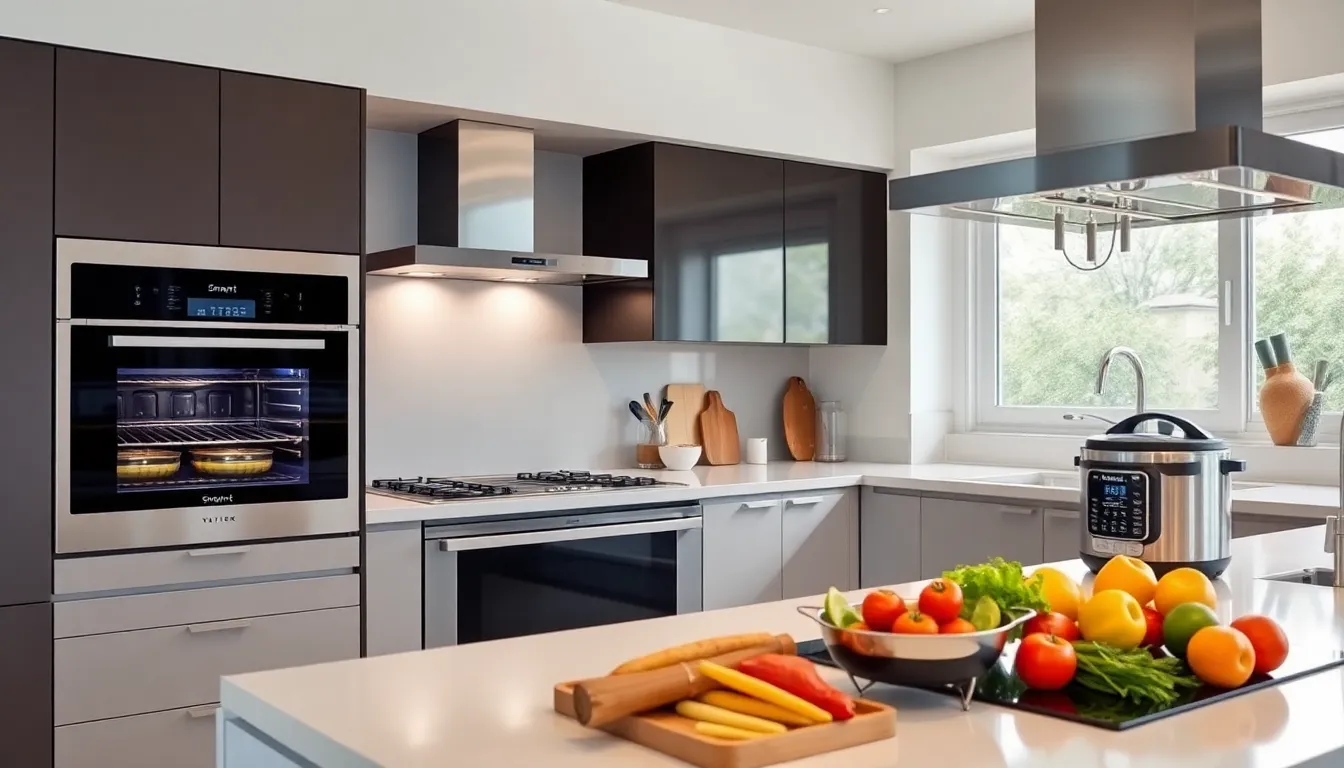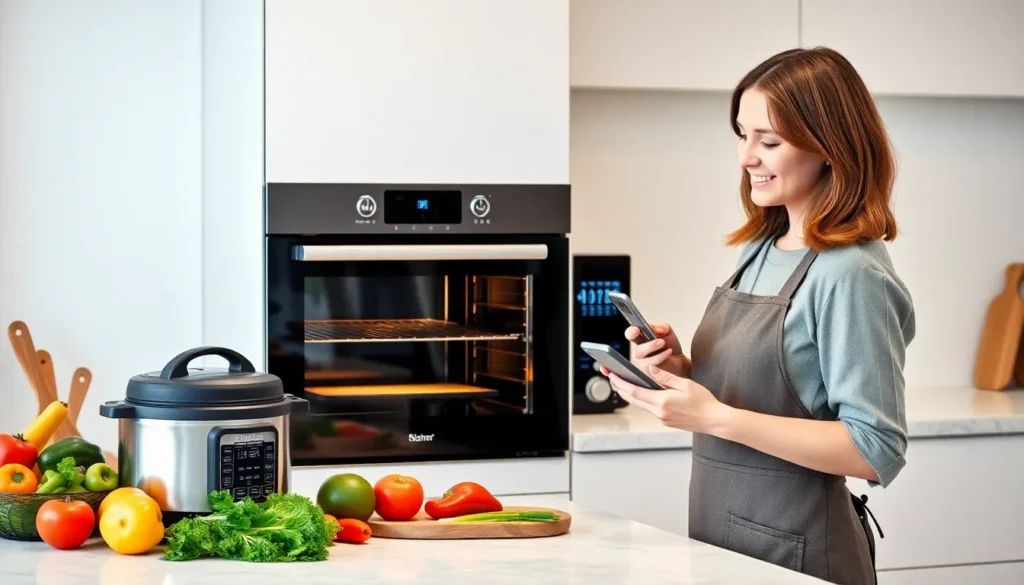In a world where even your fridge can send you a text, smart cooking devices are the culinary superheroes we didn’t know we needed. Imagine whipping up a gourmet meal while binge-watching your favorite show, all thanks to gadgets that practically cook for you. These devices don’t just save time; they make cooking feel like a fun game instead of a chore.
From smart ovens that know the perfect temperature to pressure cookers that can be controlled from your phone, these innovations are here to transform your kitchen into a tech-savvy paradise. So, if you’re tired of burnt toast and soggy pasta, it might be time to embrace the future of cooking. Get ready to impress your friends and family while enjoying delicious meals with minimal effort—because who wouldn’t want to be the culinary wizard of their own home?
Table of Contents
ToggleOverview Of Smart Cooking Devices
Smart cooking devices integrate technology into the kitchen, enhancing convenience and efficiency. These gadgets range from smart ovens to app-controlled pressure cookers, each designed to simplify meal preparation. Smart ovens can auto-adjust temperature and cooking times using recipes downloaded from apps.
Smart pressure cookers feature programmable settings that allow users to control cooking processes remotely. Users can monitor progress in real time through smartphone applications. Smart slow cookers also offer similar capabilities, letting home cooks adjust settings and receive notifications.
Some devices, like smart thermometers, ensure food reaches optimal temperatures, improving safety and taste. Smart kitchen scales help users measure ingredients precisely, allowing for accurate recipes. These devices streamline the cooking experience, minimizing the chance of errors and mishaps.
With voice assistance integration, many smart cooking devices respond to commands, enhancing hands-free operation. For example, users can dictate cooking instructions, check timers, or adjust settings while multitasking in the kitchen.
Progress in smart cooking technology has led to devices that learn user preferences, leading to personalized cooking experiences. These advancements encourage kitchen innovation, making gourmet meal preparation more accessible. Ultimately, embracing smart cooking devices elevates culinary skills, allowing individuals to impress others with minimal effort.
Types Of Smart Cooking Devices

Smart cooking devices revolutionize kitchen experiences, combining advanced technology with culinary efficiency. These devices enhance convenience and precision in meal preparation.
Smart Ovens
Smart ovens offer programmable settings that adjust cooking times and temperatures automatically. Users can control these ovens remotely via smartphone applications. Options for monitoring cooking progress also exist, providing real-time updates. Voice-controlled features enable hands-free management, making multitasking easier. Integrated recipe suggestions simplify meal preparation by guiding users through each step.
Smart Pressure Cookers
Smart pressure cookers allow users to prepare meals quickly with programmable settings and remote access. These devices often feature app-based controls that provide precise cooking times and temperatures. Users can choose from various cooking programs tailored to different dishes. Automatic pressure release functions add safety and convenience. Real-time monitoring enhances cooking outcomes, ensuring perfectly cooked meals every time.
Smart Slow Cookers
Smart slow cookers combine traditional cooking methods with modern technology for effortless meal preparation. Programming options allow users to select cooking times and temperatures remotely via an app. Some models include recipe integration, promoting meal ideas based on available ingredients. Voice command features facilitate easy operation, while notifications inform users when meals are ready. This technology offers flexibility for busy lifestyles, accommodating varied schedules.
Smart Cooktops
Smart cooktops provide precise temperature control and advanced cooking settings for a superior cooking experience. Many models offer touch controls that make adjustment simple and intuitive. Compatible apps allow users to access recipes and control cooking remotely. Some cooktops include safety features like automatic shut-off, ensuring peace of mind. Enhanced connectivity supports seamless integration with other smart kitchen devices for cohesive meal preparation.
Benefits Of Using Smart Cooking Devices
Smart cooking devices offer numerous advantages that enhance both the cooking experience and meal preparation. From saving time to ensuring precision, these gadgets transform how individuals approach cooking.
Convenience And Time-Saving
Convenience ranks high among the benefits of smart cooking devices. They automate repetitive tasks, enabling users to focus on other activities while food cooks. App-controlled features allow for remote monitoring and management of meals. Furthermore, cooking schedules can be programmed, meaning dinner could be ready right when needed. With smart ovens and pressure cookers, meal preparation speeds up significantly, reducing the overall time spent in the kitchen. Ultimately, these devices make cooking more accessible for busy individuals and families alike.
Precision And Consistency
Precision plays a crucial role in cooking success, and smart devices excel in this area. Smart thermometers provide real-time temperature readings, ensuring food is cooked accurately. Consistency is maintained through programmable recipes that adjust cooking times and temperatures based on user preferences. Many smart ovens utilize sensors to eliminate guesswork in meal preparation. With connected kitchen scales, ingredients can be measured precisely, leading to better results. These features empower users to replicate their favorite dishes with confidence, knowing they’ll achieve the same great flavor every time.
Considerations When Choosing Smart Cooking Devices
Considering several factors ensures you select the best smart cooking device for your kitchen. Key elements include connectivity, compatibility, features, and functions.
Connectivity And Compatibility
Connectivity plays a crucial role in the functionality of smart cooking devices. Devices that easily connect to Wi-Fi or Bluetooth simplify remote operations. Compatibility with smartphones and smart home systems enhances usability. Notably, some gadgets support major platforms such as Apple HomeKit, Google Assistant, or Amazon Alexa. Verify that devices seamlessly integrate with existing appliances for a smoother cooking experience. Additionally, check for regular software updates from manufacturers, which can improve functionality over time.
Features And Functions
Features greatly impact the cooking experience. Devices offering programmable settings allow users to customize cooking preferences. Advanced options, such as automatic temperature adjustments and integrated recipe suggestions, streamline the food preparation process. Gadgets with multi-cooking capabilities reduce the need for multiple devices, saving space and money. Moreover, look for devices with precise measurement tools, including integrated thermometers and scales, to enhance cooking accuracy. Robust safety features, like auto shut-off mechanisms, further contribute to peace of mind during meal preparation.
Future Trends In Smart Cooking Devices
Smart cooking devices are evolving rapidly, anticipating user needs for convenience and efficiency. Integration of artificial intelligence plays a significant role, enabling devices to learn preferences and suggest tailored recipes. User interfaces are becoming more intuitive, allowing seamless interaction through touch screens and voice commands.
Connectivity enhancements continue to shape smart cooking technology. Devices now feature advanced Wi-Fi and Bluetooth capabilities, ensuring seamless integration into smart home ecosystems. More manufacturers are prioritizing compatibility with popular virtual assistants, making cooking even more hands-free.
Sustainability is an emerging trend in smart cooking appliances, with many brands focusing on energy efficiency. Innovations in materials and design contribute to reduced energy consumption, which appeals to environmentally conscious consumers. Smart devices now allow users to track their energy usage, promoting responsible cooking habits.
Data-driven cooking is another forward-thinking trend. Devices collect cooking data, providing users with analytics to improve culinary skills. Recipe customization options are expanding, allowing for real-time adjustments based on user feedback.
Health-conscious features are gaining traction as well. Many smart cooking devices now offer meal planning functionalities, ensuring balanced diets through guided recipe suggestions. Users can track ingredient nutritional values directly within the app, facilitating healthier choices.
Finally, the social aspect of cooking is becoming more pronounced. Smart devices enable users to share recipes and cooking experiences easily with family and friends. This community-oriented approach transforms cooking into a more interactive and enjoyable process, fostering connections through culinary creativity.
Conclusion
Smart cooking devices are revolutionizing the kitchen experience. They not only simplify meal preparation but also enhance culinary creativity. By integrating technology into everyday cooking tasks, these gadgets empower users to achieve restaurant-quality results with ease.
As they continue to evolve, these devices will likely offer even more personalized and efficient cooking solutions. Embracing smart cooking technology can lead to a more enjoyable and less stressful cooking environment. With the right tools, anyone can elevate their culinary skills and impress family and friends with minimal effort.




